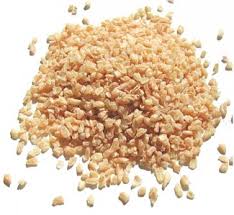Bulgur (also Burghul, bulghur, burghul or bulgar) is a cereal made from whole wheat. It is common in European, Middle Eastern, and Indian cuisine.
The advantage of bulgur wheat is that is shortens your cooking times because it only needs to be re-hydrated rather than cooked. The disadvantage is that it only stores reliability for about 6 months.
Bulgur can be used in pilafs, soups, bakery goods, or as stuffing. In breads, it adds a whole grain component. Its high nutritional value makes it a good substitute for rice or couscous. Bulgur wheat is often used as a cereal with milk and sugar in parts of India. In the United States is often used as a side dish and is a good substitute for pasta or rice. Bulgur is sometimes mistaken for rice, although it has a texture more like couscous than rice.
Bulgur is usually made from hard (red) wheat, but it can also be made from any wheat. Doing it at home renders a natural, light brown product. The pale product you see in shops has been bleached.
Here are the basics on making your own bulgur wheat
Washed whole-wheat berries are soaked overnight.
Then cook them in a covered pot (1 part wheat to 2 parts water) until soft enough to give when pinched between the fingers.
Now spread them out on cooker sheets and allow them to thoroughly dry. You can dry them in oven but do not let the temperature exceed 150° F, or dry them in the sun.
Once dried, you can run them through your grain mill at a coarse setting to crack them. If you don’t have a grain mill, you can place them in a pillowcase and use a rolling pin to crack the grain. However, this is a lot of work. If you want, you can sift it into a couple of sizes. The finer grains can have different uses, than the larger.
The bulgur wheat is now ready to use.
Bulgur should be stored in air-tight containers in a cool, dry place. It will keep well at room temperature or in the refrigerator for five to six months. Frozen, it keeps indefinitely.
In the near future, we will start putting up some recipes that show various ways to use bulgur wheat.
Howard



The disadvantage you mention about storage isn’t really that much of a disadvantage. As long as you have whole wheat berries, clean water and fuel ( which can store for longer) you have bulgur wheat.
As a point of interest, it is my understanding that in ancient times they had a lot of insect damage in their stored wheat from eggs that hatch and then the worms……well, I think we’ve all seen this! But they discovered that if they boiled the wheatberries first it killed contamination with any eggs in the grain and it stored much longer. This also led to the bulgur process, as opposed to just cracked wheat. This came from a rather obscure little cookbook, mostly by Armenians, Heritage Wheat, The Complete Bulgur Cookbook, by Sirvart K. Bedrosian. 1980.